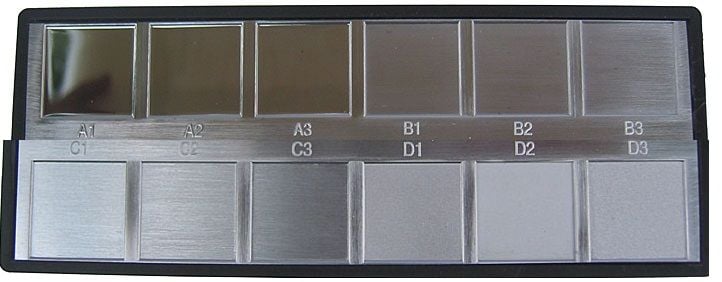
Understanding Options for Your Plastic Injection Mold Surface Finish
In some applications for plastic injection molded parts, it’s important to achieve a specific appearance. In others, surface texture influences how the part performs in service. In general, the finish produced on the surface of a plastic part mirrors that of the mold cavity. It’s essential to specify the surface finish required, as this determines how the mold is finished and thus what it will cost.
Choosing the optimal surface finish for injection molding parts requires an understanding of:
- When surface finish matters
- The definition of an injection molding finish
- How to select the Grade of SPI mold finish needed
When Does Surface Finish Matter?
The finish on the surface of a plastic injection molded part affects its appearance and can influence how it performs in service. Here’s a closer look.
Plastic resin injected under pressure takes on the texture of the surface it’s pushed against. If that surface is smooth, the resulting surface will reflect light in a way that makes it appear glossy. Conversely, a rough surface scatters light in all directions, making the surface appear dull or flat. A rough surface can also hide or disguise imperfections in the surface of the molded part.
For surfaces seen by a customer or end-user, it’s crucial to create a finish that matches his or her expectations. Surfaces that will be given a bright metallic finish should be smooth, as any imperfection will show in the reflections. On other surfaces, it may only be essential to avoid the appearance of tool marks from the mold machining process.
The surface finish affects performance in two ways. First, a rougher surface creates more friction. In sliding contact or bearing applications, too much friction can lead to rapid wear that quickly degrades performance. In liquid dispensing or transfer applications, higher friction can increase pumping loads. Higher friction can also make a product easier to grip. Hand tools and manually operated levers are examples of products where a rougher surface is desirable.
Second, surface finish affects how light passes through transparent plastics. Plastic lenses, for example, need extremely smooth surfaces to minimize undesirable light scattering. Many fluid dispensing and storage products also need good visibility so users can see liquid flowing or spot the presence of bubbles or contamination.
Injection Molding Finishes Defined
There are many ways of quantifying surface finish, the value of which depends on the application. In the plastics industry, injection mold surface finish is characterized using a system of four grades — A to D — defined by the Society of the Plastics Industry (SPI). (The SPI is today known as the Plastics Industry Association.)
Grade A is the smoothest surface and is achieved through a diamond buffing process. Grade B is a semi-gloss finish created by sandpaper. A Grade C surface is rougher still and is formed using grit sanding stones. Grade D surfaces are the least reflective and are formed by blasting with sand or glass beads.
Each Grade has multiple levels of roughness. For example, in Grade B, the surface texture could be formed by sandpaper of 320, 400, or 600-grade grit. A surface could also be left in the as-machined condition. While machining marks will show on the plastic surface, this may not matter if the surface will never be seen.
The difficulty of plastic injection mold polishing relates to the type of steel used. Low alloy P20 tool steel polishes well and is often used for Grade B finishes and below. For Grade A surfaces, it may be necessary to use H13 steel. Note also that a smoother surface takes longer to achieve.
Selecting the Grade of Mold Finish Needed
A good principle is to choose the lowest Grade that will meet a customer’s expectations for appearance and performance. Doing this also minimizes the cost of giving the mold the required surface finish. Surfaces that a customer or end user will never see could be left as-is unless part function dictates otherwise.
Get the Advice of Experts
Crescent Industries is a manufacturer of both injection molding tools and injection molded parts. Our tooling and molding specialists have the knowledge and experience to help you assess the finishes that your plastic parts and tooling need. They can also advise designing parts for injection molding and the SPI mold tooling classification appropriate for your expected volumes. Contact us to schedule an initial discussion.
Sources:
https://www.protolabs.com/resources/design-tips/sorting-through-surface-finishes/
https://www.3dhubs.com/knowledge-base/injection-molding-spi-surface-finishes/
https://www.3dhubs.com/guides/injection-molding/#design-for-injection-molding
https://www.midstatemold.com/surface-finish-in-injected-molded-parts/
https://info.crescentind.com/blog/custom-injection-molding-design-guide
https://www.kaysun.com/blog/how-to-control-your-surface-finish
Topics:
Related Articles
-
May 12, 2025
The Role of Hot Runners in Injection Molding
Read MoreBefore the invention of hot runner systems, manufacturers used cold runner injection methods. These...
-
Apr 23, 2025
How Long Does an Injection Mold Last? | Durability Factors
Read MorePlastic injection molds can manufacture custom parts in numerous industries with great accuracy and...
-
Apr 10, 2025
How Are Injection Molds Made for Plastic Manufacturing?
Read MoreDo you have a part design and need an injection mold built? Are you interested in finding a tooling...

